Porcelain Insulator News
by Elton Gish, NIA #41
Reprinted from "Crown Jewels of the Wire", January 1987, page 15
Dear Elton,
I acquired an unmarked U-498 with a powder blue glaze. It has a mold line
over the done and other Pittsburg features such as an unglazed pin hole and
circles at the top of the pin hole. Has this one been reported?
I wrote you before about two U-625's in light blue with Westinghouse
recessed-embossed marking No. 8 (see CJ August 1985 p. 19). I would like to
report a U-625 in cobalt blue with this same marking.
How common is a U-933 Ohio Brass glazeweld? I found three of these with a
mottled reddish-brown glaze. I also have a sim U-927 Thomas glazeweld with a
mottled brown glaze.

I also have a sim U-659 that was removed from an old line in West Virginia by
a contract lineman. It has a metal coated top that ends in a recessed groove
around the top of the insulator The metal appears to be aluminum. The insulator
is not marked and there is a metal thimble cemented in the pin hole.

A black
coating has been applied over the cement. I know that O-B made insulators like this, but the glaze does not appear to be
O-B. Did
other companies besides O-B make insulators with a metal coating?
Fred Collier, jr.
NIA #2933
- - - - - - - - - -
Dear Fred,
I cannot find a previous report on any of the insulators that you wrote about
and they are probably scarce in collections. There is no doubt that you are an
active porcelain collector as you keep coming up with a few goodies and
stretching my resources for all too few comments. The sin U-927 Thomas was
cataloged from 1907-1912 and maybe a few years after that. The U-498 must be
beautiful in powder blue.
The U-933 was cataloged by O-B as early as 1907 and last appears in their
1909 catalog. Since your unit has the O-B marking, we can guess that your
insulator was made between July 1907 and 1909. The O-B marking was first used
about July 1907 when they announced their agreement with Akron High-Potential
Porcelain Co. to have exclusive control of their entire output. Previous to 1907,
O-B was a jobber for Locke's "Victor" , Akron H-P and later New
Lexington insulators till their agreement with Akron. O-B bought Akron H-P in
1910 and the U-933 style was dropped. So your insulator was actually made for O-B
by Akron H-P.
The most interesting of your reports is the sin U-659 with an aluminum coated
top. Your insulator was more than likely made by O-B, but there is more to the
story. As described on page 23 of Jack Tod's 2nd edition book, Porcelain
Insulators, these units were called "Silentypes". O-B developed and
announced in 1934 a process to spray a metallic coating of copper or aluminum on
the top of the insulator. This was an expensive process yet a way of achieving
the low radio interference without infringing on the Westinghouse patents for
conductive glazes. On the following pages are copies from the 1934 O-B catalog.
Only three styles (U-876, U-894 and U-910A) of unipart pin types are
illustrated in the O-B catalog with each being available in either copper or
aluminum coatings. All styles were supplied with a cemented metal thimble.
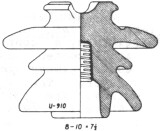
All of these styles are distinctive due to the recessed flux control groove. U-910 is another one of these units. Your sim U-659 is
the only other style reported except for the one Jack found in the Porcelain
Products Inc. dump. Apparently PP Inc. experimented with the metalized top
design as a means of eliminating radio interference. However, we have a photo
copy of an O-B blueprint dated 10-22-37 of the same PP Inc. style.
But, the story is not over yet. In Jack's book Insulator Patents, 1880-1960,
there is a reference to patent #2,274,955 assigned to Victor Insulators, Inc.
with a patent date of March 3, 1942 and filing date of September 17, 1940 (see
copy of patent pages that follow). The filing date is nine months after O-B announced their new "Conduction Glaze Silentype" insulators which
replaced the expensive metalized top units. I do not know if O-B was granted a
patent on their method to metalize porcelain insulators.
The Victor patent is similar to the O-B metalizing process in that the
"... insulator body may be suitably masked to protect any portion of its
surface, so that only the selected and exposed portion is subjected to a
coating...". Notice, too, that the patent does not refer to using a
recessed flux control groove so important in the O-B "Silentype".
Perhaps the key difference lies in the specific use of the metal antimony and the
answer to that question may never be revealed. The Victor patent claims that the
antimony coating will prevent radio interference "...while also affording an
iridescent porcelain surface that can be used as a road marker or for other
purposes.". Wouldn't these be nice to mark your driveway to help friends find
your house at night?
To my knowledge, no insulators have been found that were coated by the
process described in the Victor patent and your sin U-659 is the first report of
a unit with a metal coating. Many of these are probably still in service.
Elton
OHIO BRASS COMPANY
O-B Silentype Insulators
Designed to function without radio interference, not only at the rated
operating voltages of the insulators but also at a comfortable margin above the
rated voltages, O-B Silentype insulators are eliminating radio troubles on many
lines where checks of possible causes indicated the old insulators were
responsible for the disturbance. Costing only a few cents more than standard
pintypes and making use of old pins possible. these units provide an inexpensive
means of building good will among customers and preventing costly complaint
calls.
As shown on the following page, the radio interference levels for O-B Silentypes are from 1.4 to 3 times the line to ground voltages. These
values, or
noise levels, were obtained by lowering the voltage slightly below the point
where disturbance could be heard in the speaker of a super-heterodyne radio
receiver, located 4 meters from the insulator on test, or be seen in a cathode
ray oscilloscope, fed by the receiver. Use of the oscilloscope and locating a
sensitive receiver so close to the insulator give extra assurance that no
disturbance would result at the rated line to ground voltages in service.
O-B Silentypes banish radio interference because they eliminate air in series with
porcelain both at the tie-wire and pin hole. The head has been metallized with a
coating to redistribute the electrostatic flux in such a way that most of the
lines of flux pass directly into the porcelain. Thus. they cannot produce radio
interference by overstressing the air immediately adjacent to the conductor and
tie-wire. The top shell is undercut slightly and the metallizing brought out to
the undercut and part way upon the undercut groove.

Installing a 69-kv. multipart
Silentype, 35552
This construction causes the flux to pass from the edge of the metallizing
directly into the porcelain and thereby avoids overstressing the adjacent air.
Air is eliminated from the pin hole by cementing a metal thimble into the pin
hole. using a semi conducting cement. Thus. the flux passes from the porcelain directly
into the cement and the thimble.

A 34.5-kv. unipart Silentype, 35923
Being a counterpart in appearance. design and
manufacture of O-B's standard pintypes, the Silentype insulator have the same
balance of mechanical, electrical and thermal characteristics assuring operators
of the
long life and trouble-free service obtained from standard units.
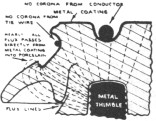
The flux distribution in the Silentype is
such that no corona exists about the
conductor, tie-wire, metal plating edge
or pin hole.
Regular Silentypes, for use with both copper and aluminum conductors. are copper
coated. Aluminum coated units, however, can be furnished should this type of
metallizing be preferred for use with aluminum conductors. Under no circumstances
should the aluminum type be used with copper conductors. Catalog information and
characteristics for all Silentypes are given on the following page.
OHIO BRASS COMPANY
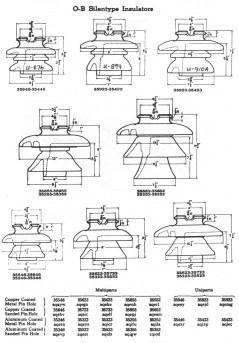
Medium Image (88 Kb)
Large Image (197 Kb)
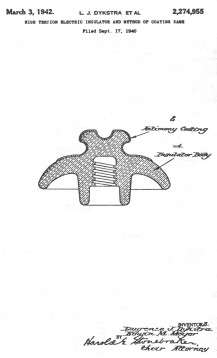
Medium Image (37 Kb)
Large Image (94 Kb)
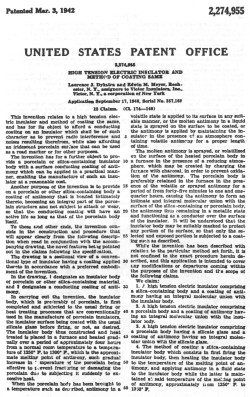
Medium Image (175 Kb)
Large Image (417 Kb)
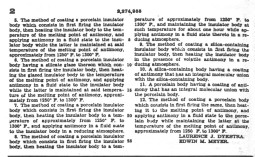
Medium Image (74 Kb)
Large Image (176 Kb)
| 